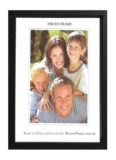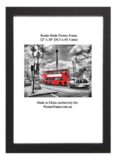![]() First, a succinct explanation of what those two frames are. A custom picture frame is a relatively expensive, single,
First, a succinct explanation of what those two frames are. A custom picture frame is a relatively expensive, single, tailor-made frame, or a bespoke frame, or one made-to-order especially for the Customer by a trained craftsman, to his or her requirements and specifications. A Ready-Made picture frame is much cheaper, one of many thousands, industrially mass-produced with unskilled labour for a common or standard size, regardless of a Customer’s requirements or specifications. That said, let’s discover the very real differences between the two and why in some circumstances the former is preferable to the latter. Custom frames are generallymade to acid-free standards, which means that the materials backing, touching or overlapping the art will not “burn” the art.
tailor-made frame, or a bespoke frame, or one made-to-order especially for the Customer by a trained craftsman, to his or her requirements and specifications. A Ready-Made picture frame is much cheaper, one of many thousands, industrially mass-produced with unskilled labour for a common or standard size, regardless of a Customer’s requirements or specifications. That said, let’s discover the very real differences between the two and why in some circumstances the former is preferable to the latter. Custom frames are generallymade to acid-free standards, which means that the materials backing, touching or overlapping the art will not “burn” the art.
What acid burn is explained in more detail in this post On Cleaning Paper Art Prior to Picture Framing. Custompicture framing normally entails a custom picture framing consultation with Customers. During these consultations the nature, importance and value of the art being framed will be discussed. Often the Customer advises that the piece requiring framing has emotional, sentimental, financial or historical importance.
This is the first and most important difference between custom picture frames and ready-made frames. When buying ready-made picture frames, there is no personal service, much less, a picture framing consultation. These frames are sold casually, indifferently and anonymously, like occasional tables, on a help-yourself basis, with no requests for advice sought or expected. Invariably these imported frames are mass-produced overseas by lowly-paid, unskilled, workers who laboriously, monotonously , soullessly and repetitively assemble picture frames day in, day out, often in unhappy and cramped conditions.

And chances are that these type of off-the-shelf frames, will not at all be suitable for valuable, cherished or important work, as outlined before. This is because pre-made frames are generally made with the cheapest materials, are often un-matted and their Medium Density Fibreboard (MDF) backing are predominantly acidic. All this is bad because of a number of reasons, the main ones being a) un-matted frames ( without a widnow mat) can cause the art to stick to glass and be damaged, and b) acidic backings can badly “burn” the art, paper or document being framed.
But Customers will be none the wiser because there is no technical consultation available when buying these frames. Salespersons won’t know any of these things and, if asked, they will most likely say that they don’t know and that they are not trained to proffer expert picture framing advice. And may we concur, that’s fair enough too.
We do not expect young, unskilled persons, often still at school and on minimum wages, to know the pertinent technical aspects of picture framing materials, methods and practices. This is specialized and expansive knowledge that can take skilled practitioners decades of practical and theoretical experience to accumulate.
A second difference between custom picture frames and ready-made frames downside to buying mass-produced, department store picture frames is that everybody seems to have the same frame. But when Customers frame something, we noticed, they want their picture frames to be different from those which other have. In other words there’s personal touch, feel, or individuality of style with such generic, run-of-the-mill photo frames or picture frames.
This is a particularly true when Customers want frames that are baroque, ornate or with silver, bronze or gold lip. Most of these finishes are unavailable or exceedingly hard-to-find at most department store photo frames sections. Conversely, these moulding variations and finishes are routine in custom picture frames.
Yet a third difference is that custom picture frames, unlike pre-made frames, can and do easily cater for odd, irregular, non-standard of unusual art, paper or photo sizes. Ready-made frames are invariably made to Imperial sizes such as 8”x10” or 11”x14” or A Series size such as A4 or A3. However and with the explosion of the internet accessibility, mobile telephones and digital imagery, many people frequently print to paper sizes which are outside either of these two standard.
In addition, the advent of inexpensive inkjet and laser printing has made it possible for people to print to whatever size they wish. And generally speaking, users enlarge a photo or an image as much as they can before losing resolution or sharpness. The result is that the finished print will can be anything but of standard size, and thus often requiring a custom picture frame, such as the panoramic photograph below:

Another, fourth difference is that with custom picture frames Customer can add colours. Have you noticed that nearly all photo stores frames are white, black or tan white only white or off-white window mats, if these have mats at all? So what happens when a Customer wants a black mat, or another colour for that matter? She or he, can’t have it with store-bough frames, that’s what happens.
But with custom picture frames, a veritable kaleidoscope of colours is available, largely, but not solely, because of the ready availability of coloured matboards. Most custom picture framers carry and stock dozens of colours in both mouldings ( frames) and matboard sheets, therefore specific colours to Customers’ specifications are possible and feasible.
It is then possible, with a custom frame, to have any custom matting of choice, with background and highlight colours, double mats, multiple layered mats, vee-grooves, accent colours, offsets, heavy-bottom mats and a host of other design and colour variations.
Still another fifth difference is the choice of glazing materials. With virtually any and all mass-produced photo frame sand picture frames Customers may expect only two types of glazing, clear glass or acrylic ( plastic). While this is passable enough for most folks and most art, it doesn’t cut it when there are special circumstances and requirements. In these cases, only a custom picture frame constructed by a picture framer will do the job.
Every now and then a Customer will come to us requesting non-glare, non-reflective, or diffused glass for a good or discernible reason. He or she may intend to hang a picture frame in close proximity to where there are large glaze areas and near-permanent glass reflection can be an uncomfortable, visual problem.
Occasionally, a Customer may intend to hang or more picture frames in busy areas, or areas where there children, or elderly residents. In these circumstances the art is best glazed with Perspex or a similar, shatter-proof, acrylic glazing material, so that in the event that a picture frame should fall down, there would be no dangerous glass shards scattered or disseminated.
In some other circumstances, a Customer may want to preserve and protect a piece of art, document or personal memento with personal significance, or attachment, or simply a valuable collectible to be protected from fading. In this case, glazing the art, piece or item with Ultra-Violet protecting glass is the recommended option as this glazing is manufactured to block out 99% or harmful ultraviolet rays.
And let us not forget a sixth difference, memorabilia picture framing, a splendid example of which is shown below. Both memorabilia and object framing are specializations of custom picture framing frequently requested by Customers. A grandfather’s World War II service pay book, dog tags, a uniform’s chevrons, and what have you are often requested to be framed by Customers.

There are also grandmothers’ thimble, needles, embroidery hoops and other assorted memorabilia which have also been frequently framed. Neither object or memorabilia framing is readily or easily possibly with ready-made or mass-produced frames because of any and all of the reasons referred to thus far.
Perhaps a seventh and last difference between the two kinds of frames is the choice and options of hanging. Most ready-made frames have slip-on hangers fitted, which, and especially on larger frames, are barely adequate and flimsy. These metal hangers ( shown below ) have only a small hanger opening which often too small to accept medium and large size wall hangers.

We have occasionally have had fix or replace to department-store frames where these hangers simply failed and broke off. Often these failures resulted in shattered glass, sprung picture frames and, sometimes, damage to the wall, to the plaster, and skirting board. Frequently these store-bough frames, if not fitted with slip-hangers, are fitted with small sawtooth hangers.

Again, these metal hangers are not ideal, especially for larger frames. While a wall hanger does fit inside a sawtooth hanger reasonably well, there’s mostly only one ever fitted and most picture frames should be hung at 2 points, for stability and added safety.
Lastly a nail or wall hook can slide sideways with these hangers and easily cause the framed artwork to fall off. Each and all of these problems can be overcome with the fitting or appropriate and professional hanging devices when making a custom picture frame. These devices can, and often are discussed with Customers during a custom picture framing consultation.
In the main these consist of durable, twisted stainless steel wire or Venetian blind cord with D-Ring hangers. We have used this hanging system for decades and have never had failure reported to us. Importantly we can fit the wire or cord to a height specified by Customer, something than cannot be done with department store frames.









